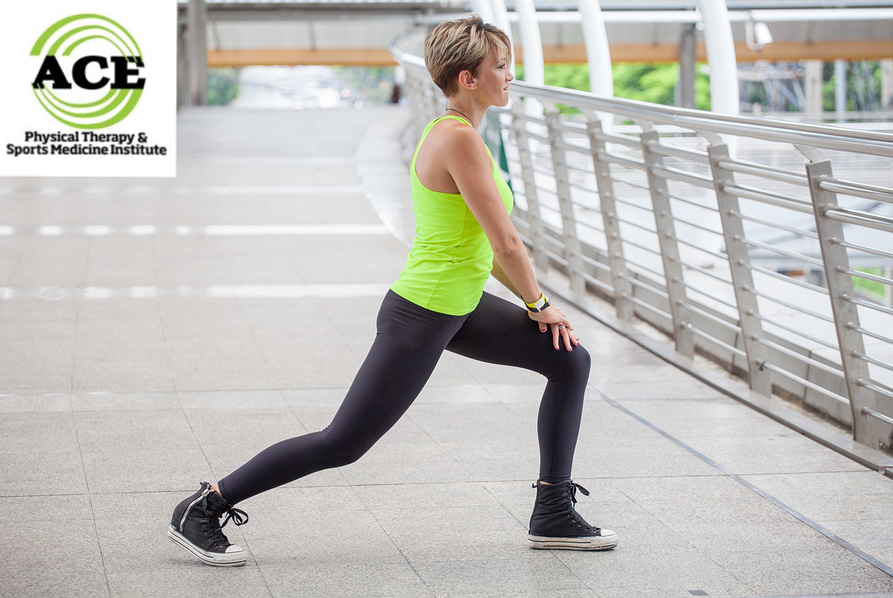CAN THE CALF MUSCLES PREVENT ANTERIOR KNEE PAIN?

Tid Bits of Info
- Nearly 20% of all running injuries can be placed in the category of anterior knee pain.
- The soleus constitutes greater than 50% of the muscle mass in the calf.
- Isolating the soleus for stretching and strengthening requires the knee to be flexed.
- Increased stride rate and reduced stride length can help to prevent anterior knee pain in runners.
- Seek the advice and treatment of a Physical Therapist if you develop anterior knee pain.
Runners sometimes begin to experience sharp pain under the knee cap or at front of the knee. This anterior knee pain or runner’s knee is actually a common injury for these athletes. Healthcare professionals regularly treat runner’s knee or patella femoral pain. When considering the multiple causes and treatments, it is important to look at the calf muscles, specifically the soleus.
Patella femoral pain in runners has been linked to high impact forces at heel strike, increased hip adduction, internal rotation, knee valgus, weak hip musculature and reduced ankle dorsiflexion. These runners also tend to have more knee flexion upon landing, and increased stride length. There are numerous protocols that deal with the above factors and one practice that is becoming more prominent is to “re-train” the runner’s gait and ground striking abilities. Increasing the stride cadence and step rate aides in reducing stride length and in turn reduces the impact force. This has proven to be more important than changing the point of contact upon impact from the heel to the mid or forefoot, but many runners make adaptations to both characteristics.
When adjusting stride or point of impact, don’t forget to consider the soleus. It must be able to handle the additional number of impacts during a run if the runner is going to shorten their stride length and change the point of impact to a mid to forefoot position. The proper strength training and gradual increase in running distance must be performed to avoid a secondary injury to the changes in running style.
There are three calf muscles, the gastrocnemius, soleus, and plantaris. The soleus makes up more than 50% of the total muscle volume in the calf. The muscle is almost all slow twitch muscle fiber (80-96% in the subjects of related studies) which enables it to contract over a long period of time. The endurance capability of this muscle is remarkable when considering the type of force that it has to handle when someone runs. The vertical force at impact during a run can be as high as 8x the body weight of the runner. The force production occurs in the form of eccentric muscle contractions (elongating fibers under great force) which is the type of contraction needed to “control” and decelerate the runner’s body weight upon landing.
The soleus’ ability to produce enough control of the runner’s leg during the later stages of their stride is thought to be due to the orientation of the muscle fibers. The soleus controls the shin bone and decelerates it as the foot is plantar flexed at the end the stride and toe-off occurs to propel the runner forward. The fiber orientation is bipennate and the angle of pennation is great enough to produce a tremendous amount of force. This orientation acts like a pulley system.

Conditioning the soleus should include stretching and strengthening. The strengthening process should focus on eccentric exercises that are performed with knee flexion angles that range from 30-60 degrees. There needs to be both high repetition and high resistance training but not necessarily at the same time. Stretching the soleus is best done with a flexed knee. The muscle does not “cross” the knee joint, therefore to attempt to stretch it with an extended knee is not advised. Squatting down and maintaining the heels on the floor is a great way to stretch the soleus.
Physical Therapists can help a treatment program. They can design an exercise routine that will enhance the strength, endurance and flexibility of the soleus. The soleus can develop trigger points that are painful “knots” in the muscle that can limit the motion of the ankle. Physical Therapists are trained to treat these painful areas to help restore the motion in the ankle.
Seeking treatment from a Physical Therapist is easy and does not require a doctor’s prescription. Your insurance policy might require a referral from your general practitioner to attend Physical Therapy treatments.
The treatment of anterior knee pain in runners has evolved and become a multifaceted approach by healthcare providers. The inclusion of a strengthening and stretching program for the calf musculature, more specifically the soleus should be a part of the entire program. Successfully training and treating the soleus can greatly enhance the probability that a runner will not have to endure the sequela of symptoms associated with anterior knee pain.
























